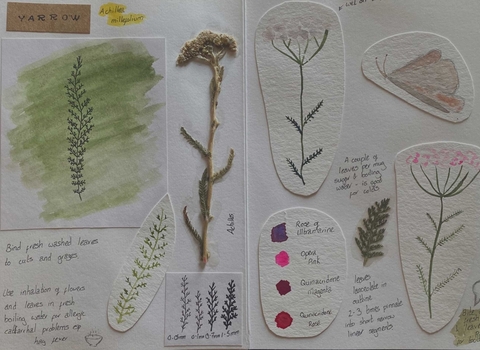Take the chance to look at nature, make sketches, observations or write about what you see.
Learn to appreciate the natural world around you. Take time to be mindful and make observations. Feel more connected, and build a deeper and lasting memory of the natural world. Uncover new ecological perspectives and ask scientific questions of the connectivity of nature.
Resources
Select a notebook or sketchbook you are comfortable with, or simply use loose sheets of paper – alternatively make your own using this guide from the Natural History Museum.
Writing instruments - Bring along pencils, pens, or coloured pencils. Waterproof ink pens can be useful if you plan on journaling outdoors in various weather conditions.
Other supplies - Consider watercolours or markers if you want to add colour. A ruler can help with drawing precise lines or borders.
How it works
Nature is filled with amazing things to discover and question. This is an opportunity to get up close and spend some time observing it. Follow the steps below as a simple guide – but remember that this is a personal journey connecting with nature.
1. Pick a location
- Choose a spot in nature that inspires you. It can be a nearby park, garden, forest, or even a verge.
- Start with locations you can visit regularly to observe changes over time.
2. Observe carefully
- Spend time quietly observing your surroundings. Take note of the colours, shapes, textures, and patterns you see.
- Use your senses: What do you hear, smell, and feel? What are you drawn to?
- Remember that you can observe something very small scale, sometimes the best journalling can be done by closely observing what is often overlooked.
3. Record your observations
- Date and location: Start each entry with the date and location of your observation.
- Sketches and drawings: Draw what you see. Don’t worry about artistic perfection—sketches can be simple. Focus on capturing the essence of what you observe.
- Written notes: Write down details such as the species you see, weather conditions, time of day, your thoughts and feelings about the environment, and what you observed whilst there.
- Getting it wrong: There is no way of getting a journal wrong. It is completely personal to you, and doesn’t have to be a work of art.
4. Add detail and notes
- Scientific names: If you know the species, include its scientific name.
- Behaviour: Note any interesting behaviours, such as a bird building a nest or the way leaves rustle in the wind.
- Questions: Record questions that arise during your observations. You can research these later or explore them in future entries.
- Lists: Include lists of birds, insects, leaves or flowers observed.
- Measurements: Add measurements or a scale to your drawings or observations.
- Patterns: Note down patterns, this could be patterns on an object or in behaviour.
5. Use prompts
- If you’re unsure where to start, use prompts such as:
- “Describe the most interesting thing you see today.”
- “What patterns can you find in the leaves or bark?”
- “How does the landscape change throughout the day?”
- “What could you smell or hear?”
- “How are you feeling?".
- Get curious – does this prompt you to look at something in more detail, or do you want to come back to the same spot and explore something else to add to your journal?
6. Review & reflect
- Look back at your entries periodically to notice patterns or changes over time.
- Reflect on how your connection with nature has deepened through journaling.
- Set aside regular time for journaling. Whether it’s daily, weekly, or monthly, consistency will help you build a habit and notice changes in your environment.
- Allow your curiosity to guide your journaling. Explore new locations, try different techniques, or focus on different aspects of nature.
- If you’re interested in learning more about your observations, you can research plants, animals, or geological features and add this information to your journal at a later date or time.
Tips for beginners
Start Small: Focus on a single tree, plant, or area to avoid feeling overwhelmed.
Be Patient: Nature journaling is about observation and connection, not speed or productivity.
Have Fun: Let your journal be a reflection of your personal experiences and creativity.
By starting a nature journal, you create a personal record of your interactions with the natural world, which can be both a relaxing and enriching experience. Use this guide from the Natural History Museum to help start your nature journalling.
Remember you don’t have to be neat/ accurate or a great artist. This is a personal time for you to spend with nature. There is never a wrong way to nature journal, its important to remember that it is the process of the nature journalling not the overall product at the end.
Use the link below to submit your activity log and photos of your pages and complete your skills section. Please have your DofE number to hand when submitting your evidence.








